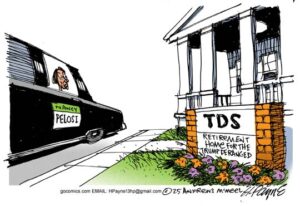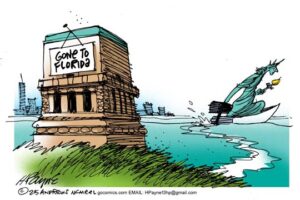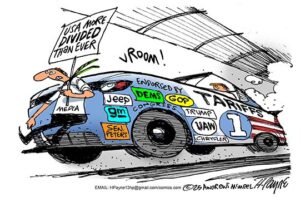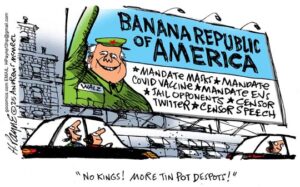Henry Payne Blog
Cartoon: Pelosi TDS Retirement Home
Posted by Talbot Payne on November 7, 2025
Cartoon: NYC Election Liberty to Florida
Posted by Talbot Payne on November 6, 2025
Payne: No window, no problem. Chasing Tesla in the sleek Polestar 4
Posted by Talbot Payne on November 6, 2025

Henry Payne, The Detroit News
Montreal — On two-lane Route 117 in Quebec, I jumped into the left lane, nailed the throttle in my 544-horsepower, 2026 Polestar 4 and — ZOT! — was past the truck in front of me in the blink of an eye. I glanced in the rear camera mirror, pulled back into the right lane, and gave the truck a wave.
Except the Polestar 4 has no rear window, and the trucker never saw my gesture. Haw.
Polestar’s latest compact SUV is quick, cool and — as its clever rear design implies — innovative; just like Tesla models that pioneered the EV segment over the last dozen years. With Tesla in mind, Volvo (and its Chinese owners) spun off its Polestar performance badge in 2017 as a full-line electric vehicle brand. Where Volvo has developed EVs with its safety and design north stars, Polestar has leaned into speed and innovation.
The fourth — and most important model to date in Polestar’s young journey — the 4 is a Scandinavian Tesla Model Y. Call it Polesla.

Henry Payne, The Detroit News
Like the camera mirror in Tesla’s Cybertruck, the 4’s rearview unit is necessitated by its radical rear roof design. Determined to make the compact SUV look like a racy sports coupe (while maintaining utilitarian rear seat and cargo space), the Polestar 4 does without a rear window, confident that the advance of digital mirrors and blind-spot assist would cover the void.
It works, though old habits (like my trucker wave) will die hard.
It’s a reminder that digital technology is changing every tool in the automobile. Cadillac innovated the camera mirror last decade. At the Detroit Grand Prix in 2018, I asked race car driver Jorden Taylor what his 600-horsepower, $730,000 winged Cadillac DPi.V.R cyborg shared with a production Cadillac.
“Two things,” said the affable race pilot. “The V-8 engine block and the camera mirror. You can’t see out of these mid-engine race cars, and the camera mirror allows me an unobstructed view out back to I can see my competitors and slower traffic around me. I love it.”
Now it’s standard in the $57,400 Polestar 4. It will not be to everyone’s liking in a ferociously competitive premium class that includes Model Y, Cadillac Optiq, Mustang Mach-E, Genesis GV70, BMW iX3 and Lexus RZ. All with rear windows.

Henry Payne, The Detroit News
What won’t be polarizing is the Polestar’s rear head and legroom. At a charging station (more on that later), I hopped into the back seat, where the standard panoramic roof arched backward above me. It easily cleared my 6’5” head before plunging into the rear tailgate, much further rearward than other roofs in the segment. The result is plenty of light for the rear passenger. Sun too strong? Opt for the cool two-mode roof that will turn opaque at a touch of a button.
I could also move the rear seat back, comfortably stretching my legs to sit behind myself. Still, competitors like Tesla and Optiq offer more room.
Like its peer internal combustion engine segment, compact EV SUVs are where the sales are, and brands have brought their A game.

Henry Payne, The Detroit News
The Model Y is so good it was the second best selling non-pickup in the market last year after the gas-powered mainstream Toyota RAV4 compact SUV. The Polestar follows the formula with distinctive styling, a simple interior and raw speed.
South Korea-made and Chinese-owned (Geely), the 4 is the third mass production model in the Polestar lineup, following the (now withdrawn) 2 hatchback and 3 midsize SUV. The 4 (Polestar numbers its vehicles in order of rollout) has matured with its own design cues.
Gone are the Volvo-like Thor’s Hammer headlights in the 2 and 3, replaced by dual-blade headlights, grille-less sports car fascia and horizontal tail lamps. The separation from Volvo is important, even as Polestar stays true to spare Scandinavian style prized by everyone from Ikea furniture to Orrefors glass shoppers.

Henry Payne, The Detroit News
The 4’s exterior is cleaner than the busier lines of the 2 and 3. With its wide stance, coupe roofline and deeply-scalloped rocker panels, the SUV gives off a sporty, athletic vibe.
The simplicity continues inside. With key in pocket, the 4 recognized me as I approached, extending the flush door handles like a handshake. When I settled into the comfortable high-backed seats, the Polestar automatically turned on. No need to touch the brake pedal, push a button, insert a key. Slick.
As was the spare interior anchored by a 15.4-inch horizontal screen. No buttons cluttered the dash or doors. Tesla-like, I adjusted my side mirrors, steering wheel and air vents in the screen. Operated by Google Built-in (like General Motors EVs), other functions can be controlled by voice command.

Henry Payne, The Detroit News
Hey, Google, set driver temperature to 70 degrees.
Done.
Hey, Google, navigate to Mont-Tremblant, Quebec.
Done.
Hey, Google, make the roof opaque.
Done.
Hey, Google, tell me a joke.
“How do trees access the Internet? They log in.”

Henry Payne, The Detroit News
I like a car with personality, and the 4 has it in droves. Tesla has fart cushions, tracks Mars, and names its drive modes (like Plaid) after the movie “Spaceballs.” Polestar tells jokes, tracks the solar system and weaves its interior fabrics like Swedish textiles.
It tracks Tesla on charging, too, with NACS (North American Charging Standard) connector so you can navigate to — and fill up at — Tesla’s ubiquitous Supercharger network.
The 4 trails the segment’s best EVs, the Model Y and Optiq, in two respects.
First, while my $64,300 all-wheel-drive tester boasts eye-popping acceleration numbers on par with a Model Y Performance, the Polestar is a significant 800 pounds porkier and a big financial ask (especially with the $7,500 federal welfare gone) for a new luxury badge.

Henry Payne, The Detroit News
Second, while the equally luxurious Optiq is also porky, both the Cadillac and the Tesla offer superior hands-free driving systems. Navigate from, say, Montreal to Detroit, and the Tesla (and Caddy) will take you there hands-free on four lanes. Not the 4, which only sports adaptive cruise control.
Still, it’s great to see a new badge mature, and the Polestar 4 is a welcome addition to the U.S. market. Just remember to roll down your window if you want to wave at the trucker you just blew by.
Next week: 2026 Nissan Sentra
2026 Polestar 4
Vehicle type: All-wheel-drive, five-passenger compact SUV
Price: Base $57,400, including $1,400 destination charge ($64,300 Dual Motor as tested)
Powerplant: Lithium-ion battery pack mated to single/dual electric motors
Power: 272 horsepower, 253 pound-feet torque (single rear motor); 544 horsepower, 506 pound-feet torque (dual front and rear motors)
Transmission: Single-speed automatic
Performance: 0-60 mph, 3.7 seconds (mfr.); top speed, 124 mph
Weight: 5,192 pounds (as tested)
Range: 310 miles (single motor), 280 miles (dual front and rear motors)
Report card
Highs: Cool design; electric performance
Lows: Polarizing design; lacks full self-drive
Overall: 3 stars
Henry Payne is auto critic for The Detroit News. Find him at hpayne@detroitnews.com or @HenryEPayne.
Cartoon: Mamdani Wins New York
Posted by Talbot Payne on November 6, 2025
EV interest waning? Honda is going all-in to be the next Tesla
Posted by Talbot Payne on November 6, 2025
Tokyo — The U.S. auto industry is navigating tricky roads as manufacturers face stalled electric vehicle demand, rising tariff costs, and intense competition. But Honda Motor Co., which counts the United States as its biggest customer with 40% of global sales and operates four manufacturing plants in three states employing over 23,000 associates, is determined to maintain a steady course.
In a wide-ranging interview at Honda headquarters in Tokyo, CEO Toshihiro Mibe said that the company remains on course for a fully electric future like Tesla Inc. and will continue to prioritize the United States for manufacturing investment.
Among legacy automakers, Honda has been — along with General Motors Co. — the most forceful in its commitment to ending the production of internal combustion engines, a challenge the company calls its Second Founding. Long one of the world’s premier ICE manufacturers — both on-road and on the racetrack — the brand gave a glimpse of its electric future this week in showcasing three near-production, so-called O-Series models at the Japan Mobility Show here.

Henry Payne, The Detroit News
Honda’s push comes despite dramatic changes in the U.S. political environment, with EV sales slowing, Congress’s elimination of the $7,500 tax break, the Trump Administration’s rollback of emission regulations, and billionaire global warming financier Bill Gates’ dismissal of a climate crisis.
“Electrification now is a little bit different from what we were expecting before,” said Mibe, who has previously projected that Honda would end ICE sales by 2040. “Maybe (we’ll see a) five-year delay as compared to our first expectations. And probably that means from 2040 on, the electrification will have to go faster. But as long as humankind has not abandoned efforts for global warming innovation, we have to keep up with our responsibility.”
Honda’s mobility presentation at the Japan Show was striking for its parallels to Elon Musk’s companies — not just in EVs, but in its commitment to a moral mission statement and the pursuit of reusable rockets.

Henry Payne, The Detroit News
“Before making a profit, there is one important condition: whether something is ‘right’ or ‘not,’” read a slide in Honda’s corporate presentation on rocket development. “We think ‘What can I do for society and for others?’ Since its founding, Honda has driven technological innovation and product development fueled by this very passion.”
That passion, says Honda, has driven its Second Founding to address global warming. The commitment dovetails with Honda’s belief that electric motor-driven technology is superior to ICE, and that customers will ultimately choose the former.

Sam Abuelsamid, Telemetry
Both Japan and U.S. customers have proven resistant to EVs, but the company has forged ahead with electrification plans. The commitment is not dissimilar to that of Toyota Motor Corp., which aimed to pioneer hybrid vehicles 25 years ago with the Toyota Prius. Once a nerdy outlier, Prius today is the halo car to a hybrid-focused model lineup.
“Honda has a long-term plan, but they are smart enough not to sacrifice their current profitable ICE vehicles to get there,” said iSeeCars.com Senior Analyst Karl Brauer. “Unlike some other automakers — Porsche, Dodge — you haven’t heard Honda say they are sunsetting ICE models to make EVs. Honda is going to make ICE Civics and CR-Vs as long as there is demand.”
Indeed, Honda gave the media a sneak peek of its next-generation midsize sedan and SUV platforms — the basis for its best-selling ICE Civic, Accord, and CR-V models — at its Toshigi Proving Grounds.

Henry Payne, The Detroit News
Tesla has been the pioneer of EV technology, accounting for 40% of U.S. EV sales. But Honda is determined to catch Tesla with its radical O Series vehicles. First up, the O Series SUV in 2026, which looks like something that drove off the set of a “Blade Runner” sci-fi movie. It will be followed by the O Series Saloon, which looks like a Lamborghini sedan, and is due late next year. The third, the O Series Alpha, debuted on Honda’s sprawling stage here in Tokyo.
The SUV and Saloon will be produced in Marysville, Ohio, which Honda has dubbed its EV Hub. The sub-compact Alpha will be made in India for Asian markets.
The 43-year-old facility is in the midst of a major manufacturing upgrade, so it has the flexibility to produce EVs, hybrid, and ICE vehicles. The reconstruction is part of a $26 billion Honda investment in its U.S. operations.
“The future is to bring something to market that people are really going to be excited about,” said Lance Woelfer, vice president for North American sales, who was in Tokyo for the Japan Show. “We showed these vehicles to our dealers not long ago and got a tremendous response. They are excited by the new design theme and how we differentiate our design from others.”

O Series production in Ohio comes as the Trump Administration has erected a 15% trade barrier to Japanese imports and 25% tariffs against Canadian imports, where Honda makes some of its Civic sedan and CR-V SUV models.
“Flexible, non-union manufacturing is Honda’s sweet spot,” said analyst Brauer. “It costs more up front than saying you’re just going to build, say, a single platform EV. But in the long run, they can build what the market demands, and it doesn’t risk a plant with no capacity, which is really expensive.”
Mibe was blunt about where Honda’s investment will be in the new tariff era: “We did consider a large investment for EV for Canada, but we’ve already decided to freeze this. For us, the U.S. market is the main market, and … we are making yearly investment of $2.5 billion into the U.S., which we plan to continue into the future as well.”
In addition to the Marysville line upgrades, Honda has begun plans to remake production of its East Liberty, Ohio, plant for more flexible production. That flexibility matches Honda’s flexible approach as it transitions to all-electric. With EV sales challenges, Mibe said the company is focused on hybrids.

Henry Payne, The Detroit News
“I believe that (hybrid) volume would continue to increase until 2030,” said the CEO. “Currently, we (sell) 0.8 million units (per year). Our prospect is that the number would go over 2 million units by 2030. The thing is, hybrids are not going to give us complete carbon neutrality . . . so the question is: how far can we continue using them? What we do after that will really depend on what the U.S. regulations might do.”
Though there are subcompact EVs in the U.S. market like the Nissan Leaf and Chevy Bolt, Mibe does think Alpha is viable here.
“Unless the battery cost is significantly lowered, the total cost of the EV cannot be reduced significantly. That’s the reality,” he said. “We are aware that there is a need to provide affordable EVs for the North American market, (but) the 0 Series Alpha size is probably too small.”
Honda and performance cars have been synonymous for decades, including the S2000 roadster and Acura NSX. But don’t expect an EV sports car anytime soon.
“I’m afraid that we will not have any option for you to drive an EV sports car,” said Mibe, though he is bullish on hybrid performance cars like the Prelude. Honda’s hybrid Formula One drivetrain will power the Aston Martin team next year.

Sam Abuelsamid, Telemetry
“We will be driving (with Aston Martin) our power unit — half of which will be engine, half (from) electrification,” he said. “This is the opportunity for us to demonstrate on electrification technology.”
As a stepping stone to its O Series models, Honda collaborated with GM to make its $50,000 Prologue EV. Mibe said such partnerships will be common in the electric era.
“Our first objective in collaborating with GM was to expand the volume so that we could reduce the cost,” the Honda CEO said. “We are continuing to talk with GM. Software development cost is very high. The more partners we work with, the more we can allocate all the development costs, and then all the costs can be absorbed.”
In addition to EVs, Mibe and North American President Kazuhiro Takizawa also pointed to Honda’s off-road and performance vehicles as a source of growth.

Henry Payne, The Detroit News
“With some models, like (Civic’s track-focused) Type R we have a sports image,” said Takizawa. “We really want to enhance our . . . off-road capability for light-truck models. Electrification is not our only challenge. We’re challenging in this field, too.”
Brauer was at the Specialty Equipment Market Association show in Las Vegas when the Japan Show opened: “It’s telling that, the same week Honda is previewing O Series EVs in Tokyo, they are also rolling out new parts from Honda Racing Corporation in Vegas to complement their gas-powered Passport and Civic models.”
Henry Payne is auto critic for The Detroit News. Find him at hpayne@detroitnews.com or Twitter @HenryEPayne.
Planet Japan: Highlights from the Tokyo auto show, and its different auto culture
Posted by Talbot Payne on November 4, 2025
Tokyo — The Japan Mobility Show is an ocean, 6,397 nautical miles, and a world away from the Detroit Auto Show.
The vehicle mix inside the Tokyo Big Sight convention center — and the streets outside — are as different from Motown’s Huntington Place as the fish in the salted Pacific Ocean versus unsalted Lake Michigan. Except the whales are in Huntington Place.
Where the streets of Metro Detroit are dominated by huge Detroit Three pickup trucks and three-row SUVs, the byways of Tokyo are awash with tiny, boxy, so-called kei cars. You won’t see the best-selling vehicle in the United States, the Ford F-150 pickup truck, because Ford doesn’t sell here — and rural pickups are small. The best-selling SUV in America, the Toyota RAV-4, is also a rare sight due to its large (by Japanese standards) size and price. Japan’s $4.25-a-gallon gas prices aren’t outrageous like Europe ($7 a gallon), but city streets are Euro-narrow.
Six-lane Route 20 runs thought the heart of Tokyo and is the city’s Woodward Avenue with a variety of supercars, European exotics and historic vehicles preening for attention. But most metro areas are a tangle of small roads and alleys with citizens crammed into tall apartment buildings.
Japan is deeply nationalistic, and the Top 10 brands here by sales are Japanese and right-hand drive. Only four non-Japanese brands stocked booths in Tokyo. Like U.S. shows, however, the floor was awash in EVs despite low Japanese consumer demand.
Here are highlights from the show floor — and the streets beyond.

Henry Payne, The Detroit News
1) Kei cars. These shoeboxes on wheels are made by every mainstream manufacturer. Encouraged by government tax policy since World War II, they are an affordable class of vehicle that fit a defined footprint and put out no more than 63 horsepower (usually from a three-cylinder gerbil wheel). Suzuki, nonexistent in the U.S. market, is the No. 2 automaker here thanks in part to prodigious kei car production. Its Tokyo show headliner? The electric Vision e-Sky Kei car.
In Tokyo drivers ride coach in kei cars next to First Class Porsches, Mercedes and BMWs. Go further out into Tokyo’s suburbs and small cities like Tochigi and Kei cars dominate thanks to their ability to shoe-horn into tight spaces, sidewalks, and garages.

Henry Payne, The Detroit News
China’s BYD made a splash here by introducing a Kei car, showing its commitment to the market. Eighty percent of Honda’s Japan sales are Kei cars like the N-Box. Its second-best seller? A small minivan called the FREED. Sightings of the Civic, Accord and CR-V (Honda’s No. 1 sellers in the States) are rare.
2) Chevy Corvete C8. Tokyo’s elite enjoy supercars like Ferraris, Mercedes-AMG GTs and Porshe 911s. Add the Corvette C8 to the list now that Chevrolet exports it from Kentucky with right-hand drive. Heads swiveled on Route 20 in downtown Tokyo as a red C-8 sauntered past.

Henry Payne, The Detroit News
3) Honda Super-One Prototype EV. If the U.S. market gets hot-hatch versions of the Honda Civic (the Si and Type R), then Honda decided Japan’s market deserves a performance version of its Kei car, the N Box. Honda calls it the Super-One and it’s a roomy, electric cutie.
The front-wheel-drive hot box debuted at the Japan Mobility Show, and though Honda has yet to publish specs for the Super-One, the little Rottweiler has a lot more grunt than the typical Kei car. That grunt gets audio in BOOST mode. GRRRRR! It most closely resembles the poor-selling Fiat 500e in the U.S. market, and Honda won’t export it.

Henry Payne, The Detroit News
4) Honda Prelude. What you will see in Japan and Detroit is the 2026 Prelude, a legendary performance car not sold since 2001. The new model is a sleek hybrid hatchback that shares its powertrain with the Civic Hybrid. Push the S-shift button and the Prelude will growl, but there is no manual transmission like the good ol’ days.
5) Jeep Wrangler. The best-selling U.S. model in the Japanese market, Wrangler is also an icon. Credit Jeep’s long history here beginning with the post-WW II occupation (Mitsubishi manufactured the original Jeep Willys here). Foreign makes are a hard sell, but Jeep has status — and Stellantis makes the effort to produce them with right-hand drive.

Henry Payne, The Detroit News
6) Mercedes-mania. Germany’s luxury brand is another icon with serious cred here. I saw everything from G-Wagons to CLAs to S-Class land yachts cruising Tokyo. Customers don’t care much for EVs — and government doesn’t mandate them — but they are fashionable among Japan’s elite, and Mercedes’ Japan stand was packed with EVs. Front and center was the gorgeous Porsche Taycan-beating, 1,341-horsepower AMG GT XX EV.
7) Subaru WRX STI. U.S. government emissions rules deep-sixed the beloved WRX STI pocket rocket, but with a new sheriff in Washington, Subaru appears optimistic about bringing it back. The STI hatchback concept looks ready to rumble.

Henry Payne, The Detroit News
Subaru didn’t tease powertrain specs, but its huge rear wing, swollen fenders and redesigned grille look production-ready. Subie’s best-seller in Japan isn’t an Outback, Forester or Crosstrek — it’s a Levorg. Le-what? Levorg is a station wagon built on the expired Legacy’s platform.
8) Honda O-Series. Honda showed its commitment to an all-electric future — internally called the Second Founding — with a third model for its battery-powered, radical-looking 0-Series sub-brand. The 0-Series Alpha will be produced in India and sold in Asia.

Henry Payne, The Detroit News
Though it shares proportions with the gas-powered HR-V, Honda CEO Toshihiro Mibe said Alpha won’t be sold in the United States due to battery costs. Alpha’s Ohio-made siblings will be sold in the States: the O-Series SUV and Saloon sedan, the wildest looking EV this side of a Cybertruck.
9) Toyota Corolla. Corolla is the vanilla of compact cars — until now. Toyota is determined to change that image with a sharp-edged concept that debuted at the Tokyo show. It looks like a Polestar and Lamborghini had a baby — powered by a trusty ol’ Toyota hybrid drivetrain.

Henry Payne, The Detroit News
10) Mazda Vision X-Coupe. Mazda stunned with the Vision X-Coupe — a sleek, long-hooded show car featuring a hybrid rotary drivetrain. But the most important Mazda in show was the new 2026 CX-5 SUV. Ditching its cursed, rotary infotainment remote-controller for a proper touchscreen, CX-5 will be even more appealing as the best performance SUV in the compact class.
Coming soon to the USA.
Henry Payne is auto critic for The Detroit News. Find him at hpayne@detroitnews.com or @HenryEPayne.
Cartoon: Trudeau Arrests Dodgers Bus World Series
Posted by Talbot Payne on November 4, 2025
Waymo driverless ride-hailing service is coming to Motown
Posted by Talbot Payne on November 3, 2025
Robot cars are coming to Detroit streets.
Waymo LLC, a subsidiary of Google parent company Alphabet, said Monday that its self-driving fleet is headed to the Motor City. The electric autonomous ride-hailing service has become a fixture in cities like Phoenix and San Francisco, where hundreds of vehicles — instantly recognized by their rooftop Lidar arrays — service hundreds of thousands of customers with no driver behind the robotaxis’ spinning steering wheel.

A Waymo One Jaguar iPace in San Francisco. The self-driving company is bringing its robotaxis to Detroit, which will be its first northern market. Henry Payne, The Detroit News
Recently, the service expanded to Los Angeles, Atlanta and Austin — and now it is expanding again with service in Detroit, plus San Diego and Las Vegas. Detroit is significant because it’s Waymo’s first northern market. Waymo said the service is targeted to operate 365 days a year through rain, sleet and snow.
The service is also notable because it uses Zeekr minivans, the first Chinese electric auto brand on U.S. streets. At its inception in Phoenix, Waymo used Chrysler Pacifica minivans, which have been phased out over time.
“Starting next week, you’ll see us manually driving around the city as we familiarize ourselves with Detroit’s historic streets before moving to autonomous operations,” Waymo said in a press release. “We’ll arrive with a mixed fleet of all-electric Jaguar I-PACE vehicles with the 5th-gen Waymo Driver and Zeekr RT vehicles equipped with our 6th-gen Waymo Driver, which will be key to driving in winter weather.”

The Waymo One Jaguar iPace allows riders in any seat but the driver seat. Henry Payne, The Detroit News
Waymos are hailed by an app similar to Uber and Lyft. Waymo is the most-used robot service in the United States and is in fierce competition with Amazon’s Zoox and Tesla Inc. robotaxis to bring driver-free ride-hailing services to U.S. customers. The latter service, which recently started testing in Austin, Texas, with human monitors on board, aims to be more affordable than Waymo by eschewing expensive Lidar arrays and navigating solely by cameras.
Waymo said that it is coordinating closely with local officials, including the Michigan Department of Transportation and the city of Detroit, as it begins its step-by-step testing approach in the Motor City. Neither MDOT nor the city offered comments ahead of the Monday announcement.
“We’re proud of our roots in Metro Detroit, including in Novi, where we’ve had an engineering team for many years,” the company statement said. Waymo’s Novi office employs several dozen engineers, technicians and test drivers.
The company has prepared for its Detroit rollout through launches in other cities, closed-track testing and forays into areas like the Upper Peninsula with snowy winter conditions. A recent Waymo blog post discussed efforts to create an “all-weather Driver.”
The first phase of the Detroit rollout will feature human drivers manually operating the vehicles to collect a highly detailed, high-definition map of the city, Waymo technical program manager Jake Tretter said in an interview.
Once that phase is complete, the vehicles will roam the streets — supervised — using their autonomous technology while a human operator sits in the driver’s seat to make sure performance is safe and smooth.
The company did not provide a timetable for when testing phases would end and the public would be able to hail self-driving rides from the Waymo app.
“Our goal is to do it as soon as possible,” Tretter said. But he also stressed the importance of building “trust and understanding” so Detroiters are ready for an eventual full launch in the city.
“It’s harder to lose the trust and try to regain that than it is to slowly build that trust and make sure that we’re working in unison with the community and policy and legislators,” he added.
The Detroit expansion will “first and foremost” focus on the city’s urban core near Comerica Park, Ford Field and Little Caesars Arena before expanding out slowly from there.
Waymo began operating as a service open to the public in Phoenix in October 2020. Since its introduction in San Francisco in 2023, it has become a tourist sensation as well as ferrying locals on their daily rounds. Waymo has been validated over 100 million fully autonomous miles and 10 million-plus trips.
In May of this year, Waymo released a study saying that over 56.7 million miles, its vehicles had 92% fewer crashes with injuries to pedestrians and 82% fewer crashes with injuries to cyclists compared to human drivers. The company’s latest data show similar rates across 96 million miles.
Still, its robotaxis have faced scrutiny from safety regulators, including a 14-month probe by the National Highway Traffic Safety Administration into more than a dozen minor crashes in which Waymo vehicles ran into parked cars and other stationary objects. Waymo recalled 1,200 vehicles, leading NHTSA to close the inquiry, Reuters reported.
 A Waymo One Jaguar iPace hustles to pick up a customer in San Francisco. Henry Payne, The Detroit News
A Waymo One Jaguar iPace hustles to pick up a customer in San Francisco. Henry Payne, The Detroit News
In addition to eventually opening its service to the public in Detroit, Waymo is partnering with organizations like the Epilepsy Foundation of Michigan.
“For many people living with epilepsy, transportation is a significant barrier. The Epilepsy Foundation of Michigan celebrates organizations like Waymo, which are leading the way in providing accessible and safe transportation solutions,” said Andrea Schotthoefer, the foundation’s president. “Their efforts show what’s possible and inspire collective action toward a future where transportation barriers no longer stand in the way of opportunity and inclusion.”
Henry Payne is auto critic for The Detroit News. Find him at hpayne@detroitnews.com or @HenryEPayne.
Cartoon: Gates Chicken Little Global Warming Not
Posted by Talbot Payne on November 3, 2025
Trump aims to open Japan to U.S. autos with tariffs. It’s a tough sell
Posted by Talbot Payne on November 3, 2025
Tokyo — President Donald Trump arrived here this week for a wide-ranging state visit with new Prime Minister Sanae Takaichi — the same week the Japan Mobility Show opened to media. With its tariff policy, the Trump administration has been determined to open foreign markets like Japan to U.S. automakers.
It’s not easy.
In exchange for a 15% U.S. tariff on goods — lower than the previously threatened 25% — Japan this summer agreed to allow the import of American-made cars without its usual, unique safety standards and testing. “Perhaps most importantly, Japan will open their Country to Trade including Cars and Trucks,” Trump wrote on Truth Social.
But as Japan’s premier auto exhibition demonstrates, Japan’s nationalistic, right-hand-drive, compact car market is unlike that in the United States, with its large pickups and SUVs. Not a single U.S. brand showed here. Unique safety standards or not, foreign markets can be rocky soil for U.S. automakers to seed sales, say industry insiders, because of vastly different market conditions.

Henry Payne, The Detroit News
It’s not just Japan. From Tokyo and China to Europe and the United States, countries have different customers and national priorities.
China, for example, has prioritized the manufacture of electric vehicles for geopolitical reasons because the nation is home to 80% of rare earth minerals needed for battery construction. The United States, on the other hand, has the world’s largest fossil fuel reserves, which the Trump administration has encouraged use of to feed popular trucks and SUVs. The European Union has targeted 2035 to eliminate the sale of gas-fired vehicles because of climate-change concerns.
Here in mineral-poor Japan, small gas-powered cars are popular despite the country’s dependence on foreign oil.
“It’s (the) nature of a country where you have large, dense cities where a lot of people live in apartments. People don’t have access to off-street parking (with charging stations) which makes owning an EV challenging,” said Sam Abuelsamid, auto analyst with Guidehouse Insights. “So gas-electric hybrids represent a significant portion of the Japanese market. They are a fuel-efficient technology without having to worry about where to plug in.”

Henry Payne, The Detroit News
Located in the dramatic Tokyo Big Sight convention center overlooking Tokyo Bay just five miles east of where Trump and Takaichi met, the Japan Mobility Show opened to the public Thursday and runs through Nov. 9. It is markedly similar to the Detroit Auto Show in its focus on home team brands. If the Detroit show is dominated by the Detroit Three, then Tokyo’s floors are the domain of the Japan 10.
The Top 10 brands in the Japanese market, according to the Japan Automotive Dealers Association, are (in order): Toyota, Suzuki, Honda, Nissan, Daihatsu, Mazda, Mitsubishi, Subaru, Lexus and Isuzu. They are all represented here. The only foreign brands on display are Germany’s BMW and Mercedes-Benz, Britain’s Mini (owned by BMW), South Korea’s Hyundai and China’s BYD.

Henry Payne, The Detroit News
So dominant is Toyota that it consumes an entire hall at the Tokyo Big Sight (separated into halls like Detroit’s Huntington Place) along with its Daihatsu, Lexus and Century brands. Combined, the Toyota quartet make up 41% of the market.
“The Japanese are the most nationalistic people on the face of the earth,” said former Ford, Chrysler and Nissan-Renault communications chief Jason Vines, who spent considerable time in Japan in the latter role.
Unlike at the Detroit show (and other big U.S. exhibits like Los Angeles and New York), European luxury manufacturers Mercedes and BMW are represented with big displays. Indeed, after the Japan 10, six of the next 10 are premium, foreign automakers: Mercedes, BMW, Audi, Mini, Volvo and Jeep.
Jeep?

Henry Payne, The Detroit News
Stellantis NV’s icon is the best-selling U.S. brand in Japan (9,633 sales in 2024, or 0.002% of market share) and is considered a premium buy with a Wrangler Rubicon four-door, for example, costing about $70,000. Vines said that famed brands like Jeep, BMW and Mercedes are coveted by upper-income Japanese in big cities.
“The Japanese love American culture and branded clothing,” the industry veteran said. “Jeep is America. Nothing says America like Jeep.”
Jeep has been a presence in Japan since the post-World War II occupation in 1945, with Mitsubishi licensed to produce the Jeep Willys in 1953. Stellantis employs 141 people across eight Stellantis brands (Jeep, Fiat, Fiat Professional, Abarth, Alfa Romeo, DS, Peugeot and Citroen) with a head office in Tokyo and two vehicle prep centers in Aichi.
Modern Jeep models, imported from the United States and Europe, come in right-hand drive here. Jeep markets include left-lane road countries like Japan, India, Australia and the United Kingdom — thus the costly investment in right-hand drive.
In addition to “localizing” Jeeps with right-hand drive and navigation systems, Stellantis upgrades them to meet Japan’s emissions standards and safety regulations.
They’re investments that U.S. automakers are generally unwilling to make for the eclectic, 4.5 million-unit Japanese market — even though it’s the world’s third largest after China and the United States.

Henry Payne, The Detroit News
“It’s tough for U.S. brands to get penetration here because they don’t make vehicles that fit in this market. U.S. vehicles tend to be too large,” Abuelsamid said.
Tesla Model 3 and Y models are outfitted with right-hand drive, but the Texas-based EV maker is a bit player here in part due to low demand for battery-powered models.
Determined to grab a piece of the premium pie, General Motors Co. has outfitted its all-new Cadillac Lyriq EV with right-hand drive. Exports to Japan began in May at a price of $75,000. Remade as an EV brand, Cadillac is looking to start fresh in Asia and Europe.
“We’ve previously operated in a niche market, but we’ll develop new demand by introducing right-side steering wheels,” GM Japan Managing Director Tadashi Wakamatsu told Nikkei Asia.
The streets outside Tokyo’s convention center look very different than those in U.S. cities. Amongst the New York City-like bustle of cabs and lux chariots are schools of tiny, so-called Kei-cars that look like shoeboxes on wheels. The Japan show floor was choked with them from multiple automakers.

Henry Payne, The Detroit News
“It’s a special segment where the vehicles are restricted in power output to 64 hp and in size to get owners on taxes and registration fees,” Abuelsamid said. “They’re easy to park in Japan’s narrow streets.”
Even Honda’s model lineup is unrecognizable here. Eighty percent of the Tokyo-based brand’s sales are Kei cars. The No. 2-seller is a small minivan called the FREED. It is rare to see an Accord or CR-V here — the brand’s Ohio-made best-sellers in the United States, where Honda sells 40% of its global product.
Japan, by contrast, accounts for just 16% of global Honda sales. Exclusive to the States are its popular, U.S.-made, midsize Pilot and Passport SUVs that don’t come in right-hand drive.


Prior to Trump’s visit to Japan, the government of Prime Minister Takaichi floated the idea of buying a fleet of Ford F-150 trucks as a show of goodwill.
“She has good taste,” Trump told reporters. “That’s a hot truck.”
Tokyo tastes occasionally run to giant GMC Hummers. But don’t expect a run on F-150s here, signaled Mike Levine, a Ford spokesperson: “We don’t have any dealers in Japan or sell any vehicles there.”
Henry Payne is auto critic for The Detroit News. Find him at hpayne@detroitnews.com or @HenryEPayne.
Cartoon: Dodgers Win Series Trump Penalizes Toronto
Posted by Talbot Payne on October 30, 2025
Payne: The CX-ceptional Mazda CX-30 proves you can have fun AND utility
Posted by Talbot Payne on October 29, 2025

Henry Payne, The Detroit News
Oakland County — My former Detroit News colleague Scott Burgess made it a practice of getting into a Porsche 911 each year as a reminder of the industry’s sports car performance standard.
The same might be said of the Mazda CX-30 Turbo SUV.
The Japanese automaker’s entry-level hellion is the SUV segment’s handling benchmark. And for 2025, it has addressed its biggest customer ergonomics complaint: the lack of a touchscreen. In an age when sport utes make up 70% of non-pickup sales due to their superior utility, the CX-30 is a reminder that you don’t have to sacrifice cargo for fun.
I couldn’t wait to drive the 227-horsepower CX-30 Turbo in my driveway each day. It made daily chores enjoyable — and often led to extended drive time as I detoured to twistier roads. On the way home from Novi, I took the Exit 18A cloverleaf off the Lodge onto Telegraph.
Twice.
I toggled SPORT mode and the delicious, smooth six-speed transmission held a higher gear. The steering felt rooted to the asphalt. I hit the brakes, rotated into the cloverleaf and nailed the throttle around the loooong 180-degree turn. All-wheel-drive, all-season tires gripped the pavement, then started to protest as I leaned the ute on its door handles. The chassis remained poised until I shot out of the cloverleaf onto Telegraph like a ball from a ship cannon. WAAAUURGH! came the satisfying engine note from the 310-torque mill.
That torque number is competitive (as is the 0-60 mph time) with a comparable $50K BMW X1, and the 3,444-pound Mazda feels more planted in part because it’s a significant 300 pounds lighter than the Bimmer. The Mazda looks leaner, too, with its shark-nose hood and clean lines compared to the current-gen German’s chunky styling. Only heavy plastic makeup around the wheel arches and rocker panels compromise the CX-30’s premium look.

Henry Payne, The Detroit News
Regular readers know I think hot hatches are the best value in autodom: fun to drive, hatchback utility, affordable price.
At $35K, my CX-30 Carbon is as close to a hot hatch as any SUV I’ve driven. Call it a hoot ute.
Which makes sense because the CX-30 shares its bones and drivetrain with the Mazda3 Turbo hatch, one of the top all-wheel-drive hot hatches in the business along with the VW Golf GTI and Toyota GR Corolla.
But where those hellions’ DNA isn’t translated to their brands’ subcompact SUV offerings, the VW Taos and Toyota Corolla Cross, CX-30 is a Mazda3 on stilts.

Henry Payne, The Detroit News
Many buyers will find that an upgrade is worth the corresponding SUV upcharge.
The Mada3 is the best-looking hatchback on the market thanks to its fastback design, which comes at a price: blind spots the size of Texas, and a dungeon-like rear seat for passengers.
The CX-30 Turbo, meanwhile, maintains a sleek, narrow greenhouse roofline (which is why designers added those big plastic wheel arches) but with a smaller c-pillar design that makes for an airier backseat and better outward visibility.
Significantly, the CX-30 only adds 52 pounds compared to its hatchback sibling so it can dance with you through the curves. In a terrific subcompact ute class loaded with personality — think Taos, Chevy Trax, Buick Envista, Subaru Crosstrek — the CX-30 separates itself from the pack with its athletic talent.
When you’re not flinging the CX-30 from corner to corner, drink in the sumptuous interior of my Carbon edition: heated, power terracotta leatherette seats, leather steering wheel, leather shift knob and an elegant, horizontal dash that cradles the infotainment screen like a beach chair in a sand dune. I slipped into the Mazda as comfortably as if it were a BMW.
Also like BMW, Mazda years ago adopted the German’s rotary console controller — but without redundant touchscreen control. The controller has proved awkward for many a user. Thankfully, the advance of phone apps has come to Mazda’s rescue.
Android Auto and Apple CarPlay have proved more adept at navigating to our destinations while also bringing our phone apps into the car, and Mazda has embraced that innovation as a cure to its touchscreen woes. That is, when Android Auto/Apel CarPlay are in control of the screen, it is fully touch-capable.

Henry Payne, The Detroit News
I paired my phone with the CX-30 and never used Mazda’s native radio and navigation system — or remote controller.
“Navigate to Zmash Padel in Sterling Heights” I barked and Google Maps guided me while the phone kept its spark via a wireless charger. I pinched the screen to widen/narrow the map view. Along the way, I poked at the screen to choose my favorite Sirius XM stations.
Otherwise, Mazda ergonomics are as carefully engineered as the performance suspension. That high screen kept my eyes on the road, and climate controls are nicely designed to direct air — or close completely if so desired. The steering wheel is carefully designed with raised buttons so I could toggle radio volume and adaptive cruise control without ever looking down.
Speaking of ACC, the CX-30 is loaded with standard safety features including blind-spot assist in the mirrors, blind-spot assist in the instrument display, auto headlights, rear cross-traffic alert, tire pressure monitoring and parachute escape pod (kidding about that last one). Oh yes, and a passenger-side ceiling grab handle for Mrs. Payne to hang onto when her husband sees a twisty road. Just like a Bimmer.

Henry Payne, The Detroit News
Curiously, Mazda has neglected to give the CX-30 shift paddles — even on the aggressive, high-horsepower Turbo model. More than once, as I wound the engine out to max RPM, I reached for a shift paddle only to grab air.
There was little air in the back for my 6’5″ legs when I tried to sit behind myself. The Mazda is small for its class with 36.3 inches of rear legroom compared to, say, the 38.7-inch Trax. But then, it only gives up half an inch to the $50K BMW X1. Recognizing the issue, Mazda engineers have scalloped out the rear of the front seats to offer more knee room. But scalloping can’t help the rear cargo space, which is five cubic feet smaller (20.2) than the Trax or BMW.
A friend took his Mazda3 Turbo out west recently and tried to take a shortcut across a dirt road — pulling his exhaust shield off in the process. If he’s tempted by more off-roading in the future, he might consider the CX-30, which clears the road by another 2.5 inches.
And when it returns to asphalt, the hoot ute still begs to be rowed hard.
Next week: Polestar 4
2025 Mazda CX-30 Turbo
Vehicle type: All-wheel drive, five-passenger subcompact SUV
Price: Base $27,395, including $1,420 destination charge ($34,935 Carbon Turbo as tested)
Powerplant: 2.5-liter, inline-4 cylinder; 2.0-liter, turbocharged inline-4
Power: 191 horsepower, 186 pound-feet torque (2.5L); 227 horsepower, 310 pound-feet torque (turbo)
Transmission: Six-speed automatic
Performance: 0-60 mph, 6.2 seconds (Car and Driver); top speed, 126 mph
Weight: 3,444 pounds (as tested)
Range: EPA est. mpg, 22 mpg city/30 mpg highway/25 mpg combined (Carbon Turbo as tested)
Report card
Highs: Hot hatch SUV; improved infotainment system
Lows: Small back seat, and cargo spacefor class
Overall: 4 stars
Henry Payne is auto critic for The Detroit News. Find him at hpayne@detroitnews.com or @HenryEPayne.
Cartoon: Freedom Lincoln, MLK, Kirk
Posted by Talbot Payne on October 28, 2025
Cartoon: NBA Gambling, FBI Investigation
Posted by Talbot Payne on October 28, 2025
Cartoon: Highway Signs HOV-FSD
Posted by Talbot Payne on October 25, 2025
Cartoon: NBA Gambling FBI Investigation
Posted by Talbot Payne on October 25, 2025
Cartoon: Media Divides Tariffs Unite
Posted by Talbot Payne on October 23, 2025
Cartoon: No Kings More Queens
Posted by Talbot Payne on October 23, 2025
Payne: Taking the sci-fi Tesla Cybertruck to work on the farm
Posted by Talbot Payne on October 23, 2025
Stratford, Virginia — If I had pulled up to the Lee family home in 1776 in a Tesla Cybertruck, they would have thought I was a time traveler from the future.
Which is not much different than the reaction I received when I pulled up in 2025.
I took a Cybertruck on a weekend trip with Mrs. Payne this fall to help prepare Stratford Hall, the historic home of signers Richard Henry Lee and Francis Lightfoot Lee, for next year’s 250th anniversary of the Declaration of Independence. Our Turo rental was mobbed by Stratford volunteers, staffers and board members as if I had driven onto campus in a Tron Light Cycle.

Henry Payne, The Detroit News
If the Ford F-150 is America’s best-selling pickup, then Cybertruck is its most famous. Six years after its wild Silicon Valley introduction, the electric pickup still creates a buzz.
From its radical shape to its face-flattening speed to its self-driving capabilities, Cybertruck is a celebrity that looks like it rolled off a sci-fi movie set. Bladerunner, Tron, Mad Max — take your pick. When I wasn’t giving thrill rides to just about everyone on the 1,800-acre Stratford farm, the truck was proving itself a useful Swiss army knife hauling cargo.
It is still a rarity — particularly in places like rural Virginia, where full-size work trucks are everywhere — with its rich, $82K starting price and propensity to attract domestic terrorists who want to blow it up. I was encouraged by the truck’s enthusiastic reception, a promising sign the furries have moved on to other targets. Still, the truck’s high price and sluggish sales are surely a disappointment to Tesla.
With Cybertruck, CEO Elon Musk was determined to jump-start the EV revolution in the market’s highest-volume segment. But the high price of batteries — and their inherent towing limitations — has kept Cybertruck (and other EV pickups) from competing in mass-volume, $40K truck business fleets.

Henry Payne, The Detroit News
Cybertruck competes against premium, country-club trucks like the Ford F-150 Raptor, Ram 1500 RHO, Chevy Silverado High Country, GMC Hummer EV and Ford Lightning Platinum EV.
In truth Cybertruck is a class of one, the most radical vehicle of the 21st century.
Begin with its polarizing design. Everyone has an opinion. The truck’s militaristic vibe skews male, but female reactions were all over the map.
Very futuristic.
It’s ugly.
Can you take a picture of me with the Tesla so I can share with my kids?
Where’s the machine gun turret?

Henry Payne, The Detroit News
I’ve driven Tesla’s distinctive model lineup extensively, and Cybertruck’s design is the most extreme. Yet, once inside, I was reminded how similar its operation is to its siblings. iPhone simple aesthetics. Horizontal lines. Mono-screen housing most controls: mirror/steering position, climate controls, even shifting.
To a non-Tesla user, it’s an alien landscape.
Exiting Metro D.C.’s Reagan National Airport, I barked my destination to the truck — “Navigate to Tesla Supercharger in King George, Virginia” — then didn’t touch the wheel for the next 48 miles. As I tuned Sirius XM stations, Cybertruck drove itself through D.C. traffic, the I-495 Beltway and Maryland routes 210 and 301 before exiting to fill up on electrons for the weekend ahead.
The FSD (Full Self Driving) system has made steady strides since its 2020 introduction. The truck slowed down to avoid a rogue trash can in the road and executed round-abouts with aplomb. On other occasions it maneuvered uncomfortably close to other vehicles, a reminder FSD still needs a chaperone.
Hands-free driving and stainless-steel skin just scratch the surface of its ambitions. Cybertruck’s also the first vehicle to market with variable electronic steering. Together with all-wheel steer, it makes the 19-foot-long beast feel smaller than it is.

Henry Payne, The Detroit News
Once Cybertruck had delivered me to the Supercharger in a Sheetz lot, I needed minimal steering input to maneuver it in place next to the charging stalls. The truck ID’d an open space, then backed itself in. Whoa. Not so “whoa” are Tesla charging cables designed for compact Model 3 and Model Ys — not Cybertruck ocean liners. The cord just reached the left-rear-fender-mounted NACS port.
Twenty-five minutes later, I exited onto rural-lanes roads with 80% battery capacity. Enough self-driving. Time to wring the truck’s neck over the twisted roads of Virginia’s Northern Neck.
ZOT!
Cybertruck blew by a line of traffic on two-lane Route 3 in the blink of an eye. Car and Driver recorded the 6,634-pound Cybertruck hitting 60 mph in just 3.9 seconds (the same as a 3,241-pound Porsche Cayman GTS, for goodness sake). On a narrow secondary road, it felt like warp speed.
That precise variable steering and adaptive shocks helped keep Cyberrocket grounded. But with all-terrain tires and air suspension, the Tesla’s natural habitat is off-road. Perfect for Stratford farm’s endless fields (or Detroit’s pocked streets).

Henry Payne, The Detroit News
I stopped at a Marathon service station outside Stratford and loaded the pickup’s cooler with ice. Cooler?
Tesla is synonymous with frunks (front trunk) and Cybertruck is no exception. But Tesla also sports a substantial, sub-bed locker space.
I emptied four bags of ice and only filled it halfway. Throw in a case of bottled water and I was a rolling fridge for thirsty Stratford staff.
Cybertruck’s six-foot bed is also unorthodox with its sloped panels. They make it difficult to load from the sides, but twin 110-volt plugs and a 240-volt plug are a tailgate party’s friend. The automatic tonneau cover is a welcome innovation for inclement fall weather. As I hauled beverage cases and event signage, protecting my cargo from a sudden change in weather was as simple as pressing the screen’s tonneau cover button.

Henry Payne, The Detroit News
I crisscrossed the farm’s dirt roads and grassy fields. Giant Pirelli Scorpion all-terrains are complemented by an air suspension so I could hike Cybertruck’s steel skirts to 16 inches off the ground. Shred a tire and it will cost (cough) $529 to replace. On the other hand, Stratford’s landscape chief Matt Peterschmidt approved of the simple drop-gate compared to competitor’s multi-action contraptions.
“Tailgates are the first thing to fail on a pickup,” he smiled.
In the middle of a field, I asked the truck to self-drive back to the main house and, remarkably, it found the fence opening and got to the main road.
At weekend’s end, I headed back to D.C., the truck’s 320-mile range proving accurate (I got 98% of predicted range) despite my heavy left foot.

Henry Payne
Turo required the Tesla be returned with 80% battery range, which exposed the EV’s weakness compared to gas-powered peers: efficiency. Tesla’s Supercharger network was accessible — even in rural Virginia — but charging back to 88% (at the closest charger to the airport) from 32% added 40 minutes to my 90-minute journey. Cost? At 44 cents-per-kWh, the same as $2.75-a-gallon gas in an 18-mpg F-150 Raptor.
While it may look like it came from Mars, Cybertruck proved right at home at the historic preserve. Heck, in 1776 — after the shock wore off — the Lees probably would have adopted it for use in the American Revolution. After all, its stainless-steel skin is bulletproof.
Next week: 2026 Nissan Sentra
2025 Tesla Cybertruck
Vehicle type: All-wheel-drive, five-passenger pickup
Price: Base $82,235, including $1,995 destination charge ($90,235 with FSD as tested)
Powerplant: 123 kWh lithium-ion battery pack mated to dual electric motors
Power: 593 horsepower, 525 pound-feet of torque
Transmission: Single-speed automatic
Performance: 0-60 mph, 3.9 seconds (Car and Driver); towing, 11,000 pounds
Weight: 6,634 pounds
Range: 320 miles on full charge
Report card
Highs: King of the Road; FSD OMG
Lows: Polarizing styling; $$$$
Overall: 4 stars
Henry Payne is auto critic for The Detroit News. Find him at hpayne@detroitnews.com or @HenryEPayne.
Cartoon: No Kings Tin Pot Depots Walz
Posted by Talbot Payne on October 22, 2025














